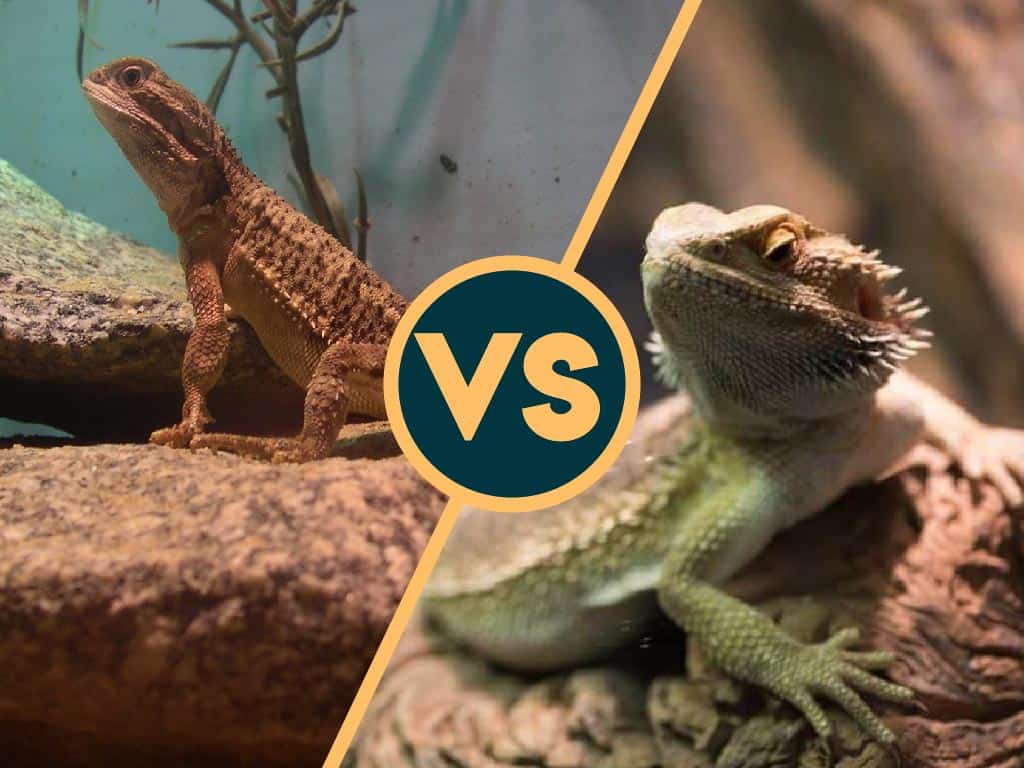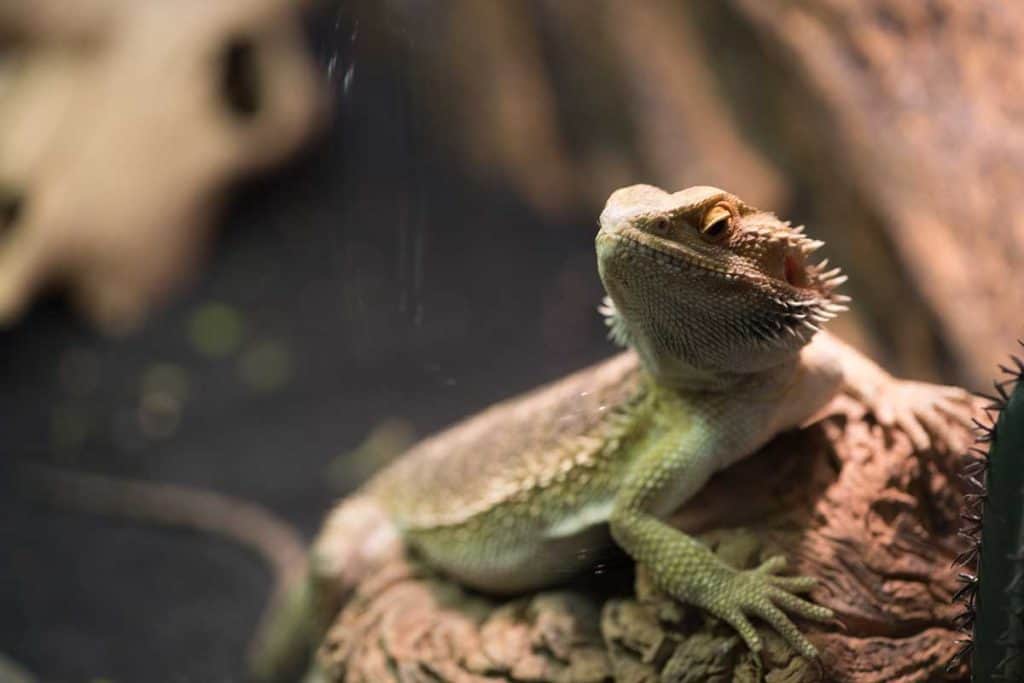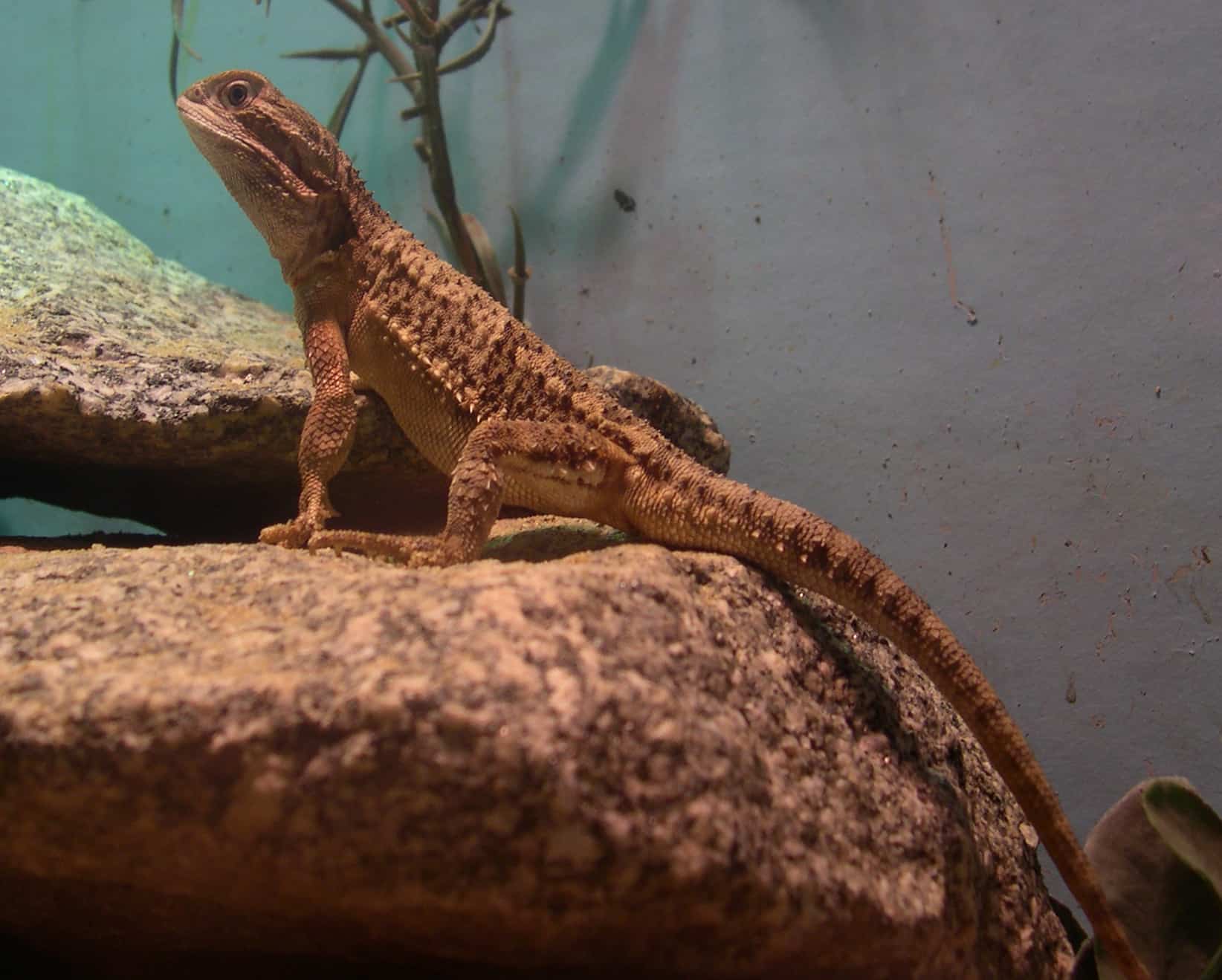
Struggling to tell the difference between your Rankin’s Dragons and Bearded Dragons? Don’t worry our Rankins Dragons vs Bearded Dragons guide has all the information you need to quickly tell the difference between these popular species of lizard.
The Bearded Dragon Family
There are eight subspecies of Bearded Dragons from the genus Pogona which come from different parts of Australia:
- Central or Inland Bearded Dragon (often simply referred to as a bearded dragon) (Pogona vitticeps)
- Rankin’s Dragon (also sometimes known as Lawson’s, Dumpy Dragon, Pygmy Dragon, or Black-soiled Bearded Dragon) (Pogona henrylawsoni)
- Eastern, Coastal, or Common Bearded Dragon (Pogona barbata)
- Drysdale River, Small-scaled, or Kimberly Bearded Dragon (Pogona microlepidota)
- Abrolhos Dwarf Bearded Dragon (Pogona minor minima)
- Mitchell’s Bearded Dragon (Pogona minor mitchelli)
- Western Bearded Dragon (Pogona minor minor)
- Nullarbor Bearded Dragon (Pogona nullarbor)
The Central Bearded Dragon is the most common of the Bearded Dragons so when you hear people talking about a Bearded Dragon that’s typically the type they are talking about.
Check out our essential guide to Bearded Dragons.
Rankin’s Dragon vs Bearded Dragon: Key Differences
The Pogona vitticeps or Central Bearded Dragon is the largest of the lot, while the Pogona henrylawsoni, or the Rankin’s Dragon, is one of the smallest.
The biggest differences between Rankin’s Dragons vs Bearded Dragons are:
Life span
- Rankin’s Dragons live on average between 6 and 10 years.
- Bearded Dragons typically live between 10 and 15 years.
Size
- Rankin’s Dragons grow to a maximum of about 12 inches in length.
- Bearded Dragons can grow up to 24 inches in length.
Enclosure Size
- Rankin’s Dragons need an enclosure that is around 40 gallons.
- Bearded Dragons need an enclosure that is around 60 gallons due to their much larger size.
Appearance
- Rankin’s Dragons have a much rounder head.
- Bearded Dragons have a pointy head.
Personality
- Rankin’s Dragons are very sociable and do well living in colonies.
- Bearded Dragons are solitary animals and rarely tolerate living in pairs.
Diet
Both Rankin’s Dragons and Bearded Dragons are omnivores and enjoy a diet of insects and vegetables, however Bearded Dragons need a lot more food than Rankin’s due to their size.
Cost
Rankin’s Dragons usually cost more because they are harder to breed and young Rankin’s Dragons require more specialized care than Central Bearded Dragons. That said Central Bearded Dragons need larger enclosures and more food so there probably isn’t a huge difference in cost over the long term.
Neither dragon is better than the other, it all comes down to personal preference and what other reptile pets you have. For example, if you are looking for a colony of sociable dragons, then the Rankin’s Dragon is for you.
On the other hand, if you want a solitary dragon that chills on your shoulder and is more low-maintenance to care for, then the Central Bearded Dragon wins!
Central Bearded Dragon Overview
The Central or Inland Bearded Dragon is by far the most widespread and popular dragon of all of the Pogona subspecies. They are found all over central and eastern Australia. These are the most common Bearded Dragon subspecies that you’ll find in pet shops.
The Central Bearded Dragon is a sought-after pet for experienced as well as first-time owners because they are very low maintenance, hardy, and docile lizards. The Central Bearded Dragon is a great pet for older children, teens, and anyone interested in regularly handling and bonding with their scaly friend.

Central Bearded Dragon Lifespan
The Central Bearded Dragon has an average lifespan of around 10 to 15 years. With good husbandry, this bearded dragon can be your companion from the time you are in middle school to the time you move into your own home!
However, this also means you need to be prepared for a long-term commitment when you buy one. If you still want a Bearded Dragon but do not think you can manage 15 years or even 10 years, then adoption is an option! Go to your local animal shelter and see if they have any adult Bearded Dragons that have been brought in and are looking for a loving home for the rest of their years.
Central Bearded Dragons are hardy and docile animals which don’t require much specialist care. This is another reason why they are such popular pets for novice and expert reptile hobbyists alike.
Check out our Bearded Dragon care guide.
Central Bearded Dragon Size
The Central Bearded Dragon measures on average between 18 and 24 inches. Males are usually longer and heavier than females because they are more territorial and dominant.
There is also a Pogona vitticeps morph called the German Giant that averages at 27 inches in length!
The size of a Bearded Dragon, like its lifespan, does however vary based on family history. If possible, ask the breeder you purchased your lizard from for a copy of the growth chart of both parents of your Bearded Dragon so you can compare the growth rates.
There are some things that you can do to help your dragons reach their full size, such as making sure they get a balanced diet and providing them with a correctly sized enclosure. As you might expect, though, there are also plenty of factors that will slow or stunt their growth, such as malnutrition and illness from poor husbandry or hygiene.
Central Bearded Dragon Enclosure
Enclosure size is important to consider. Lizards in captivity need space to roam around. If they are kept in an enclosure that is too small, they will experience stress and health issues that can shorten their lifespan.
Both dragons are mostly terrestrial lizards, so they need more space on the horizontal axis rather than the vertical axis. The Central Bearded Dragon should be housed in an enclosure that is around 60 gallons with more horizontal space than vertical space. This provides them with plenty of room to move around on the ground.
Because they are heavier dragons, they do not really climb except onto sturdy rocks and branches. Make sure that your Central Bearded Dragon has ample space to run around on the floor of their enclosure and a couple of large, solid objects to climb on, as well as a basking platform.
Central Bearded Dragon Lighting Schedule
Central Bearded Dragon’s require around 12 to 14 hours of light per day, to replicate their natural environment. Use a UVB lamp and a ceramic
Have a look at our guide to the best basking bulbs for Bearded Dragons.
Central Bearded Dragons should be basking in about 40-42°C with the shady end of the enclosure being around 22-25°C. Use a temperature gradient to keep an eye on this.
Central Bearded Dragons Humidity
Bearded Dragons don’t come from humid environments so humidity should never get too high – you should aim to keep their enclosure between around 30-50 degrees. You can measure this using a reptile humidity gauge.
Central Bearded Dragon Diet
Make sure your Central Bearded Dragons get a varied diet of vegetables like collard greens, turnip greens, dandelion greens, and insects. They also need a constant supply of fresh water to drink. Check out our guide to the best greens to feed your beardie.
If you’re worried that your lizard isn’t getting enough balance in their diet then it might be worth getting some vitamin supplements.
Central Bearded Dragon Appearance
The Central Bearded Dragon is the type of dragon you’re probably most familiar with. They are a mottled tan color with dark markings across their skin. They have two rows of small, soft spikes that run from their beard down the sides of their bodies.
There are many different kinds of color morphs of the Central Bearded Dragon. The morphs focus on the coloration, such as Leucistic and Fireball Bearded Dragons, size, such as the German Giant Morph, and scale texture, such as the super-smooth Silkies and Leatherbacks.
As a result, you have a bit more variation to choose from if you opt for a Central Bearded Dragon over a Rankin’s Dragon.
Central Bearded Dragon Personality
Sociability is a big factor when it comes to owning a lizard. Many people want to own a lizard specifically to handle it. If you’d rather have a more ornamental reptile that doesn’t need to be handled, then have a look at getting a Chameleon or a Green Anole. These are beautiful lizard species who do not do well with frequent handling.
The Central Bearded Dragon is very sociable with humans if it is trained and tamed properly when it is a juvenile. Bearded Dragons have fairly sharp teeth and claws and will let you know if they are unhappy. Many owners get discouraged at the first nip or scratch and simply do not try to handle their beardies again.
The key with Central Bearded Dragons is gentle consistency. Once you get to a point where your Bearded Dragon is comfortable with you, then they become very chilled, docile lizards. They will happily relax on your shoulder and watch you work, game, or read for a very long time.
However, while they typically play well with humans, they do not do well with other Central Bearded Dragons. Males cannot be kept together and will become very territorial and stressed even if they are in separate enclosures but can see each other.
It is possible to keep two females or a male and a female together in the same enclosure as long as you increase the size of the enclosure to at least 70 gallons and add in additional hides, water bowls, and keep a sharp eye out for bullying or competing for resources.
Rankin’s Dragon Overview
Rankin’s Dragons are also known as Lawson’s Dragons or Pygmy Bearded Dragons. They are not the smallest of the subspecies–that honor actually goes to Pogona microlepidota, or the Drysdale River Bearded Dragon.
However, they are much smaller than the Central Bearded Dragon, and they also come from a smaller region. They are found strictly in the Queensland area of Australia. These lizards are a lot rarer which means you might not find them in all pet stores and they will also be more expensive.
The Rankin’s Dragon’s scientific name is henrylawsoni because it is named after the famous colonial Australian poet and writer Henry Lawson.

Rankin’s Dragon Lifespan
The Rankin’s Dragon has an average lifespan of 6 to 10 years. This is a shorter lifespan than the Central Bearded Dragon, and it is likely because they are much smaller.
When you are purchasing your Bearded Dragon or Rankin’s Dragon, ask the breeder how old the parents are and how long they are predicted to live, as this information can give you an estimate on how long your dragon will live.
Even though they don’t live quite as long as Central Bearded Dragons, 6 to 10 years is still a long-term commitment, so make sure you are ready before you buy a Rankin’s Dragon of your own.
Rankin’s Dragon Size
The typical Rankin’s Dragon measures between 8 and 12 inches in length. Females are generally longer and heavier than males because they need the space to produce eggs.
Again, there is no objective winner here; it all comes down to your preference for a larger or smaller lizard. Remember that bigger dragons will have a bigger appetite, which will eventually cost more in the long run. They also need larger enclosures than smaller lizards.
Both the Central Bearded Dragon as well as the Rankin’s Bearded Dragon are good sizes for handling even though they are very different animals. You will always need two hands to support a Central Bearded Dragon’s body and tail properly, while you will probably only need one hand to fully support a Rankin’s Dragon’s body.
Rankin’s Dragon Enclosure
Rankin’s Dragons enjoy climbing on branches, settling in the leaves, as well as running around the floor of their enclosure. They are semi-arboreal and semi-terrestrial, so they need some vertical height to their enclosure as well as lots of floor space.
Individual Rankin’s Dragons should be housed in a 40-gallon enclosure. Even though they are half the size of the Central Bearded Dragon, they cannot be housed in a 20 or 30 gallon enclosure. They need adequate space to roam, hide, and feel comfortable, so they don’t become bored lizards.
Make sure there are natural rocks, slate rocks, fake plants or branches for your beardie to climb over and hide behind. Also Rankin’s Dragons love water so it’s a good idea to have a pool for them to soak in from time to time.
Rankin’s Dragon Diet
Rankin’s Dragons are omnivores so they need both vegetables and animal protein in the form of insects. Look for leafy greens like romaine lettuce, mustard greens and carrot greens.
Make sure there is plenty of clean water too, and invest in multi-vitamins or
Rankin’s Dragon Lighting Schedule
Rankin’s Dragons need about 10-12 hours per day from UVB lights and then complete darkness in the evening so that the lizard develops a clear day night cycle. Use a ceramic heat emitter or
Rankin’s Drgon Humidity Levels
Rankin’s don’t need high humidity levels as they don’t originate from a humid area. Aim to keep the enclosure’s humidity levels at around 40%, and make sure the enclosure is well ventilated.
Rankin’s Dragon Appearance
Rankin’s Dragons share similar physical characteristics with Central Bearded Dragons; however, the tips of their heads and snouts are shorter and much more rounded.
A Rankin’s Dragon looks a bit like it’s run into the glass wall of their enclosures one too many times! Their beards are also not as prominent as those of Central Bearded Dragons.
Rankin’s Dragons also have longer, more spindly-looking legs, which are better designed to lift their smaller, more agile bodies and help them climb branches with ease.
Both subspecies have many different morphs, and some come with serious health concerns, so make sure you do your research! For instance, the Silkie Morph has such delicate skin that direct prolonged exposure to a UVB bulb will cause serious burns.
Rankin’s Dragon Personality
Rankin’s Dragons are very sociable with humans and love being handled. They will even happily roam around a secure room and play with you for enrichment purposes.
It’s important to note that Rankin’s Dragons tend to be a bit more scatty and fussy as juveniles so they’re a better option for experienced reptile owners.
What is great about them, though, is that they can live in a little colony! Three females or two females and a male will happily live in the same enclosure, as they are quite social with each other.
However, the same rule applies here as it did with the Central Bearded Dragon — you cannot house multiple males together in the same enclosure.
For every Rankin’s Dragon you add to an enclosure, the enclosure needs to grow by at least 10 gallons. Therefore, if you have three Rankin’s Dragons in one enclosure, it needs to be a minimum of 60 gallons, and it must have multiple hides and places to drink to avoid resource competition.
Bearded Dragons vs Rankin’s Dragons Recap
Let’s recap these species’ main differences between Central Bearded Dragon vs the Rankin’s Dragon.
Central Bearded Dragons live longer than Rankin’s Dragons. Central Bearded Dragons live on average 12 years, whereas Rankin’s Dragons live for around 8 years on average.
Additionally, Central Bearded Dragons are much larger and heavier than Rankin’s Dragons. Central Bearded Dragons can grow up to 24 inches in length, whereas Rankin’s Dragons are only about half that size. This means central beardies need larger enclosures at around 60 gallons, and Rankin’s Dragons need smaller ones at about 40 gallons.
There are also some distinct physical differences between the Central Bearded Dragon and the Rankin’s Dragon, but the most notable one is the shape of the head. The Rankin’s Dragon has a much rounder, shorter head than the Central Bearded Dragon.
Finally, both dragons do very well with handling and human contact. However, if you are looking for a dragon that lives in a small colony then the Rankin’s Dragon is your winner! If you’d rather have a single lizard to focus on, though, a Central Bearded Dragon is probably a better choice.
Can I Keep a Bearded Dragon and a Rankin’s Dragon in the Same Enclosure?
Even though they are both from the Pogona family and are both technically Bearded Dragons, they are separate subspecies and would not interact together well. They should always be housed in separate enclosures.
At the Tail End of Things…
Neither the Bearded Dragon nor the Rankin’s Dragon is objectively “better” than the other. Have a think about what you’re looking for in a pet and the life you can offer it so you can choose the right lizard for you.






